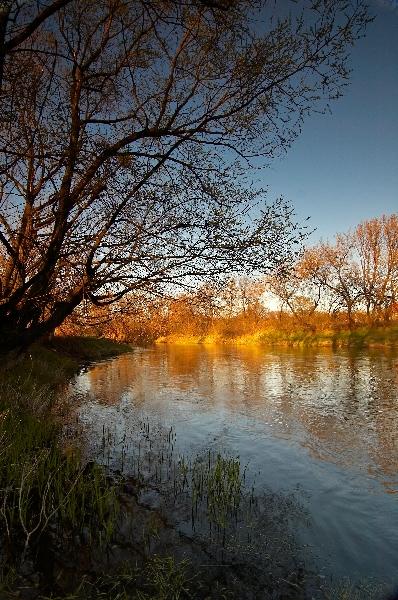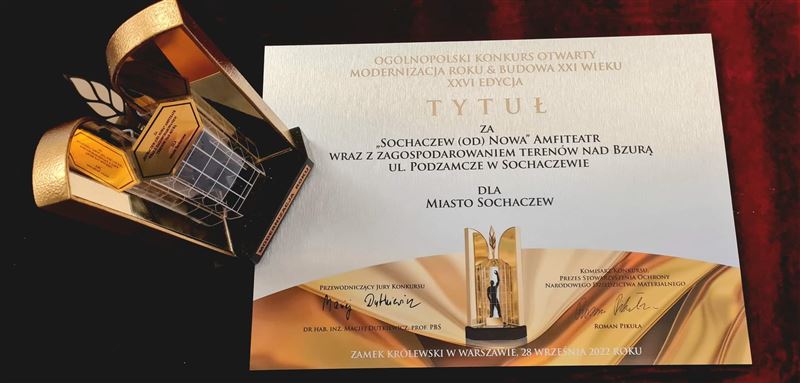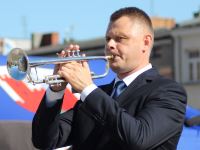Welcome to Sochaczew!
.jpg)
Location and climate
Sochaczew, a capital of a county (poviat), is populated by 36.900 inhabitants. It is situated on the edge of Łowicko-Błońska Plain, in the western part of the Mazovian Province, upon the Bzura River and its tributaries: Utrata and Pisia. The town is located in the vicinity of three agglomerations: Warsaw (50 km), Łódź (70 km) and Płock (60 km). Sochaczew is an important communication junction, it lies at the intersection of the following routes: A2 (Berlin – Warsaw – Moscow) motorway, national road No 2 Świecko – Terespol national road No 50 Ciechanów – Płońsk – Sochaczew – Grójec – Ostrów Mazowiecka, local road No 705 Wyszogród – Śladów – Sochaczew – Skierniewice, local road No 580 Sochaczew – Żelazowa Wola – Warsaw.
| A major part of the town is situated on the right bank of the Bzura River, whose valley is considered an ecological corridor of national importance (source: ECONET – POLSKA). In the direct vicinity of the town there stretches the Kampinoska Forest, a Global Biosphere Reserve, and the Middle Vistula Valley – pan-European ecological corridor, important for the preservation of biodiversity. The tree stand of the forests consists mainly of pines, oaks and birches, and in the river valleys remains of alder forests, as well as willows, poplars, bird cherries and alder buckthorns can be found. |
History
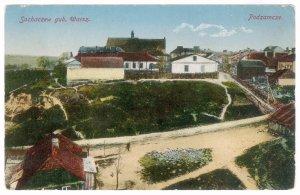 The oldest traces of Sochaczew colonisation have been discovered in the today’s town districts Boryszew and Karwowo, where during archaeological works Mezolithic and Neolithic ceramics, flintstone tools and stone axe were found. In 1959–1961 during the excavations carried out in Trojanów, over 220 graves/cremation burials were uncovered. The cemetery was used from the 5th until the 1st century B.C. Similar graves were found in 2003 in Chodaków Zwierzyniec. There are also some findings of Roman coins from the 1st-2nd century A.C. made in Boryszew. The remains of early mediaeval settlements were uncovered during the excavations at the place called Poświętne (the Staszica and Farna streets), where relics of sacral buildings as well as ossuaries were found. Archaeological excavations at the Castle Hill proved that as early as in the 13th century there existed a wooden castellan stronghold with a moat and a rampart made of timber and earth. In the mid-14th century, a brick castle was built in lieu of the stronghold which was burnt down by the Lithuanians and Russes. The first mentions of Sochaczew as a seat of the stronghold starosts date back to 1221, however it originated from a marketplace settlement, established in the 10th or 11th century at the intersection of trade routes from the East to the West and from the South to the North.During the reigns of the Mazovian Princes, Sochaczew was a densely populated town with developed handicraft. It received its town charter before 1324 and in 1377 it was there that the prince Siemowit III announced “The Sochaczew Statutes” – a collection of laws for the entire Mazovian Province.
The oldest traces of Sochaczew colonisation have been discovered in the today’s town districts Boryszew and Karwowo, where during archaeological works Mezolithic and Neolithic ceramics, flintstone tools and stone axe were found. In 1959–1961 during the excavations carried out in Trojanów, over 220 graves/cremation burials were uncovered. The cemetery was used from the 5th until the 1st century B.C. Similar graves were found in 2003 in Chodaków Zwierzyniec. There are also some findings of Roman coins from the 1st-2nd century A.C. made in Boryszew. The remains of early mediaeval settlements were uncovered during the excavations at the place called Poświętne (the Staszica and Farna streets), where relics of sacral buildings as well as ossuaries were found. Archaeological excavations at the Castle Hill proved that as early as in the 13th century there existed a wooden castellan stronghold with a moat and a rampart made of timber and earth. In the mid-14th century, a brick castle was built in lieu of the stronghold which was burnt down by the Lithuanians and Russes. The first mentions of Sochaczew as a seat of the stronghold starosts date back to 1221, however it originated from a marketplace settlement, established in the 10th or 11th century at the intersection of trade routes from the East to the West and from the South to the North.During the reigns of the Mazovian Princes, Sochaczew was a densely populated town with developed handicraft. It received its town charter before 1324 and in 1377 it was there that the prince Siemowit III announced “The Sochaczew Statutes” – a collection of laws for the entire Mazovian Province.
 The prince also reorganised the government system and introduced the office of a starost. In the 15th and 16th centuries, Sochaczew and its surroundings flourished. In 1476, the town was incorporated into the Crown and with the many privileges granted by king Casimir IV Jagiellon it grew rich and became an important centre of crafts and culture. Unfortunately, the economic growth of Sochaczew was soon stopped by the so-called ”Swedish Deluge” in the mid-17th century. Political events of the 18th century also affected the town. On 14 February 1769, the Bar Confederation was established in the Sochaczew region, and in 1794 the Kościuszko Uprising took place, during which the town was destroyed by the Prussians. The fall of Sochaczew after the events of the 18th century was sealed by the subsequent fires in 1808 and 1818. Despite these calamities, the convenient location of the town contributed to its rebirth. Until the November Uprising, the governing bodies of the Polish Kingdom appropriated vast amounts of money for the town development. In 1824, a new layout of streets was designed, and a causeway as well as a bridge over the Bzura river were built.
The prince also reorganised the government system and introduced the office of a starost. In the 15th and 16th centuries, Sochaczew and its surroundings flourished. In 1476, the town was incorporated into the Crown and with the many privileges granted by king Casimir IV Jagiellon it grew rich and became an important centre of crafts and culture. Unfortunately, the economic growth of Sochaczew was soon stopped by the so-called ”Swedish Deluge” in the mid-17th century. Political events of the 18th century also affected the town. On 14 February 1769, the Bar Confederation was established in the Sochaczew region, and in 1794 the Kościuszko Uprising took place, during which the town was destroyed by the Prussians. The fall of Sochaczew after the events of the 18th century was sealed by the subsequent fires in 1808 and 1818. Despite these calamities, the convenient location of the town contributed to its rebirth. Until the November Uprising, the governing bodies of the Polish Kingdom appropriated vast amounts of money for the town development. In 1824, a new layout of streets was designed, and a causeway as well as a bridge over the Bzura river were built.

The second half of the 19th century was an unfavourable period in the Sochaczew history. The inhabitants earned their living by cultivating grain, therefore they suffered much during the years of agrarian crisis 1880–1895. Moreover, the railway network and the industry in general were underdeveloped. It was only about 1903 that the railroad linking Warsaw, Łódź and Kalisz was built. The World War I caused the town losses and destruction. From December 1914 until July 1915, Sochaczew was the arena of fierce stationary fights at the German and Russian front line, running along the Bzura and Rawka rivers.
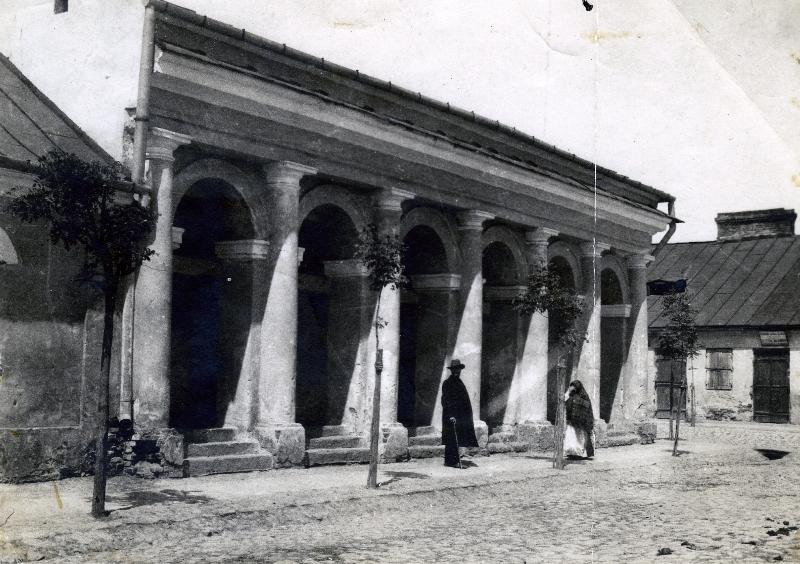 After the World War I, the town developed: many industrial as well as public utility facilities were erected. In 1939, Sochaczew was populated by 13,500 people.
After the World War I, the town developed: many industrial as well as public utility facilities were erected. In 1939, Sochaczew was populated by 13,500 people.
Unfortunately, the World War II brought about destruction again. Since the very beginning of the German invasion, the Nazis terrorised the Sochaczew dwellers. They wiped-out most of the Jewish community which constituted almost 1/4 of the town population. On 17 January 1945, Sochaczew was conquered by the Red Army which crushed the German forces. In 1985 the town was awarded a Polish order: the Grunwald Cross of the 3rd class, for the heroism of its dwellers during the World War II.
After the WW II, Sochaczew grew owing to industrialisation and inflow of people from the neighbouring villages. Housing, commerce and services flourished. In 1977, the neighbouring Chodaków was incorporated into the town, and in the 1990s Sochaczew had almost 40,000 inhabitants. Those changes strengthened the role of Sochaczew as the regional centre of economy, administration and culture. In 1999 following the administration reform the town regained the position of the poviat seat, lost in 1975 .
Monuments and culture
 One should start the tour of cultural attractions and historic monuments of Sochaczew from visiting the Kościuszki Square, the main representative town square, a former marketplace. On the western side of the square, the St. Laurel Parish Church is situated. In October 2003, a monument commemorating two great Poles – pope John Paul II and cardinal Stefan Wyszyński was erected in front of the church.
One should start the tour of cultural attractions and historic monuments of Sochaczew from visiting the Kościuszki Square, the main representative town square, a former marketplace. On the western side of the square, the St. Laurel Parish Church is situated. In October 2003, a monument commemorating two great Poles – pope John Paul II and cardinal Stefan Wyszyński was erected in front of the church.
The Classicist building of a former town hall of 1826 located on the northern side of the square is currently the seat of the Museum of the Sochaczew Region and the Battle of the Bzura River. A permanent exhibition showcases a collection of items from the World War II. The most important parts of the exhibition are small arms, equipment, LBE, uniforms, documents and photos of the Polish Army soldiers who took part in the battle on the Bzura river and in the defence of Sochaczew in September 1939. These items, found on the battlefield by the Museum employees, donated by the inhabitants of the Sochaczew region, or the families of soldiers killed during the battle and those who survived, form a unique collection, one of the most extensive collections of this type in Poland and abroad. In the Museum courtyard, an outdoor exhibition of armoured equipment of the Polish Army is located, including a barrel of the wz. 1897 field cannon cal. 75 mm and a bridge pontoon used during the battle on the Bzura river in September 1939, a T-34/85 tank, a wz. 1939 anti aircraft cannon 85 mm, and a MIG-21 R aircraft. During various temporary exhibitions held in the Museum, Polish contemporary art is presented, as well as ethnography of Poland and the world, and the historical monuments of the Sochaczew region. The Museum carries out research on the pre-history and history of Sochaczew and the whole region; it also collects records and material culture monuments, and publishes its own materials.
Near the Museum, at the intersection of the Farna and Toruńska streets, the oldest building in the town is situated, erected at the turn of the 19th and 20th centuries (Farna 13). The cobbled Farna street used to go along the town defensive walls to the church, destroyed in 1793, situated in Poświętne, the oldest sacral place of the historic Sochaczew.
Opposite the Kościuszki square, there is a Town Park with a monument commemorating Frederic Chopin. In the vicinity, at the foot of the castle hill, an open amphitheatre with a concert hall is situated. This place is called by the inhabitants Podzamcze (surroundings of the castle). Many regular outdoor cultural events take place there, including the most popular annual “The Sochaczew Days”, which are celebrated in the second weekend of June.
 On the enbankment of the Bzura river, at a site easy to defend, there protrude the ruins of the castle of Mazovian Princes, the most valuable historical monument in Sochaczew. The history of the castle dates back to the 14th century. It was destroyed many times, the most severely during the Polish-Swedish war in 1655, and in 1794 during the Kościuszko Uprising. Now, only the ruins remain, and many mysteries related to the castle history still wait to be unveiled. The castle hill is a perfect sightseeing point. You can see a picturesque panorama of the town centre and the Bzura river. During The Sochaczew Days, mediaeval tournaments lovers can travel back in time, as Stowarzyszenie na Rzecz Historycznej Odbudowy Zamku w Sochaczewie „Nasz Zamek” <“Our Castle” Association for the Historical Reconstruction of the Sochaczew Castle> and the Draconia Duchy reconstruction group organise an event promoting the history of the town.
On the enbankment of the Bzura river, at a site easy to defend, there protrude the ruins of the castle of Mazovian Princes, the most valuable historical monument in Sochaczew. The history of the castle dates back to the 14th century. It was destroyed many times, the most severely during the Polish-Swedish war in 1655, and in 1794 during the Kościuszko Uprising. Now, only the ruins remain, and many mysteries related to the castle history still wait to be unveiled. The castle hill is a perfect sightseeing point. You can see a picturesque panorama of the town centre and the Bzura river. During The Sochaczew Days, mediaeval tournaments lovers can travel back in time, as Stowarzyszenie na Rzecz Historycznej Odbudowy Zamku w Sochaczewie „Nasz Zamek” <“Our Castle” Association for the Historical Reconstruction of the Sochaczew Castle> and the Draconia Duchy reconstruction group organise an event promoting the history of the town.
While walking around the town, at the intersection of the Farna and Staszica streets, the visitors may also see a monument commemorating king Boleslaus III the Wrymouth, one of the most notable and bravest rulers of the Piast dynasty. The monument now stands where the Benedictine monastery used to be located, in which the king died in 1138.
In the town centre, at the intersection of Warszawska street and 1 Maja steet, another historic building, the Stalls (Kramnice), may be seen. These old market halls are important for Sochaczew as they present the past glory of the town. They were designed by Bonifacy Witkowski and built in 1828–1833 by Abraham Szweycer of Łęczyca. The Classicist building catches the eye with characteristic arcades and Tuscan half-columns.
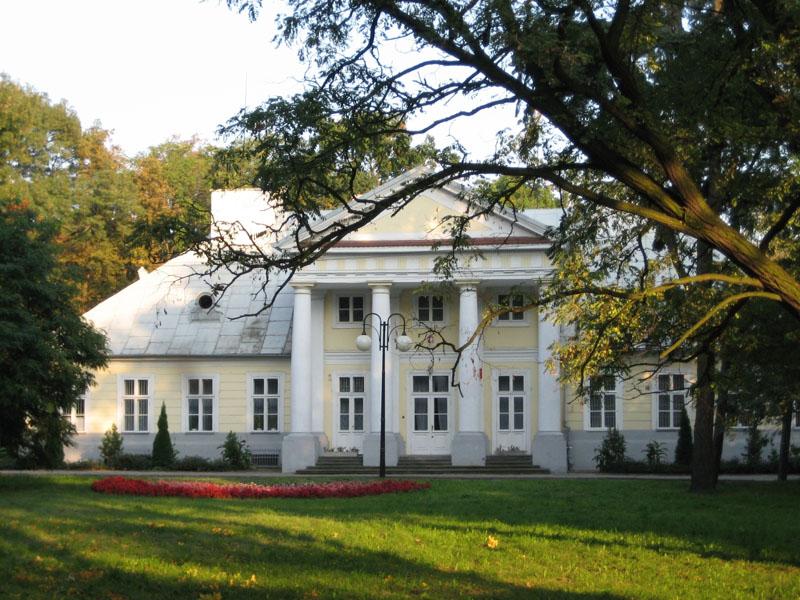 A monument worth seeing is also a Classicist mansion-house built around 1800, surrounded by a naturalist park full of old trees. From 1855 until the beginning of the World War II, it was a property of the Garbolewski family. Now it is the seat of the Frederic Chopin State School of Music of the 1st and 2nd degree with over 300 students. The School organises many festivals, music competitions and concerts attracting not only the inhabitants of Sochaczew and the neighbourhood, but also the fans of classical music from all over Poland. These include: Sochaczewskie Spotkania Kameralne (chamber orchestral music) and Sochaczewskie Spotkania Młodego Wiolonczelisty (cello competition for the youth), Ogólnopolski Konkurs Skrzypcowy ”Janko Muzykant” (nationwide violin competition for children) and Ogólnopolski Wiosenny Festiwal Fletowy (flute festibval), as well as Międzynarodowy Festiwal Chopinowski na Mazowszu (festival of Chopin’s music). Starting from May, outdoor concerts are organised, where you can listen to the performances of the School students as well as renowned artists of international fame.
A monument worth seeing is also a Classicist mansion-house built around 1800, surrounded by a naturalist park full of old trees. From 1855 until the beginning of the World War II, it was a property of the Garbolewski family. Now it is the seat of the Frederic Chopin State School of Music of the 1st and 2nd degree with over 300 students. The School organises many festivals, music competitions and concerts attracting not only the inhabitants of Sochaczew and the neighbourhood, but also the fans of classical music from all over Poland. These include: Sochaczewskie Spotkania Kameralne (chamber orchestral music) and Sochaczewskie Spotkania Młodego Wiolonczelisty (cello competition for the youth), Ogólnopolski Konkurs Skrzypcowy ”Janko Muzykant” (nationwide violin competition for children) and Ogólnopolski Wiosenny Festiwal Fletowy (flute festibval), as well as Międzynarodowy Festiwal Chopinowski na Mazowszu (festival of Chopin’s music). Starting from May, outdoor concerts are organised, where you can listen to the performances of the School students as well as renowned artists of international fame.
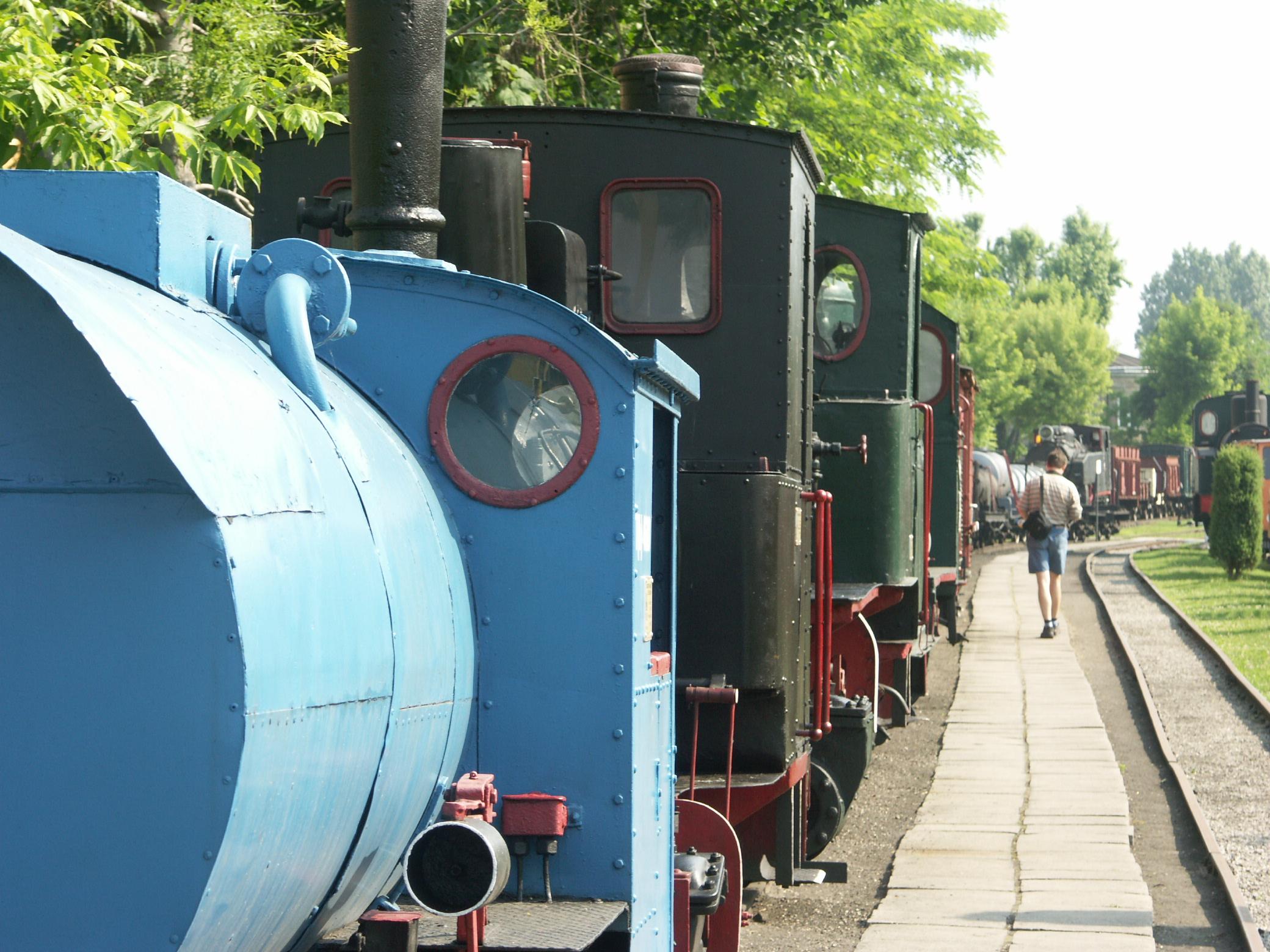 Famous tourist attraction in Sochaczew is also the Narrow-Gauge Railway Museum, situated only 100 metres away from the railway station. The Museum, established in 1986 as a branch of the Polish State Railways Museum in Warsaw, houses a collection of narrow-gauge vehicles which is the biggest in Europe. Apart form an outdoor exhibition, one can see there the collection of many interesting old photographs, scale-models, clothes, etc., gathered in a former railway station building from 1920. In summer, the Narrow-Gauge Railway Museum organises regular trips in a vintage narrow-gauge railway cars. The destination is Tułowice, a village in the Kampinoska Forest, where you can have a rest in the bosom of nature, and eat traditional roasted sausages at the bonfire.
Famous tourist attraction in Sochaczew is also the Narrow-Gauge Railway Museum, situated only 100 metres away from the railway station. The Museum, established in 1986 as a branch of the Polish State Railways Museum in Warsaw, houses a collection of narrow-gauge vehicles which is the biggest in Europe. Apart form an outdoor exhibition, one can see there the collection of many interesting old photographs, scale-models, clothes, etc., gathered in a former railway station building from 1920. In summer, the Narrow-Gauge Railway Museum organises regular trips in a vintage narrow-gauge railway cars. The destination is Tułowice, a village in the Kampinoska Forest, where you can have a rest in the bosom of nature, and eat traditional roasted sausages at the bonfire.
The remnants of the rich history of Sochaczew are its cemeteries. A historic Jewish Cemetery was founded in the 16th century and refurbished in 1991. It is a special place for Jews, descendants of the 500 years-old community. The necropolis is regarded as one of the oldest cemeteries in Poland. Abraham Bornstein – a tzaddik (Hasidic spiritual leader) from Sochaczew was buried here.
Close to the Jewish necropolis, the Saint Laurel Parish Cemetery founded in 1830 is located. Within the cemetery there are: the Tomicki family chapel of the mid-19th century, the orthodox church chapel erected before 1914, and the graves of soldiers who died in September 1939, including the grave of major Feliks Kozubowski, the Sochaczew defence commander.
Opposite the parish cemetery, at the Traugutta street, a lovely roadside statuette of St. Mary with the Child is displayed, on a brick, clad column decorated with a cube cornice, dated back to the turn of the 18th and 19th centuries.
On the grounds adjacent to the Frederic Chopin Secondary School of General Education, there was an old Muslim cemetery. Now only the remains of the Muslim chapel (the Mullah tomb) erected in the first half of the 19th century can be seen.
In the Sochaczew district of Trojanów, a cemetery founded in 1893 is situated. There are graves of 3693 soldiers of “Pomorze” and “Poznań” armies, who died during the Battle of the Bzura River in 1939.
In Chodaków – a former industrial district of Sochaczew, now quiet and full of greenery – an old watermill of the Repsz family is located. The history of the mill dates back to the 15th century. The whole estate belonged to the Duke Radziwiłł and was bought by Karolina Repsz. Until World War II, the Repsz family run a farm, a small business and a corn mill. During World War II, the house and the mill served as the headquarters of the Home Army structures (Polish resistance organisation) and a support for partisans. It was also from here that transports of food were expedited to Warsaw, including aid for soldiers fighting in the Warsaw Uprising in 1944. Nowadays the watermill is still operating, although some elements of its equipment come from the 18th century.
 Cultural life of Sochaczew is animated by the Municipal Centre of Culture. In its three facilities it runs various sections and interest groups, promoting dance, music, arts and theatre. The Centre has an amphitheatre, gallery, cinema and a cafe. It organises concerts, previews, competitions and regular events, such as Christmas carols concert, orator’s competitions and the Sochaczew Festival of Polish Films, in cooperation with the Provincial Pedagogical Library.
Cultural life of Sochaczew is animated by the Municipal Centre of Culture. In its three facilities it runs various sections and interest groups, promoting dance, music, arts and theatre. The Centre has an amphitheatre, gallery, cinema and a cafe. It organises concerts, previews, competitions and regular events, such as Christmas carols concert, orator’s competitions and the Sochaczew Festival of Polish Films, in cooperation with the Provincial Pedagogical Library.
The Teacher’s Club is also active in Sochaczew, playing an important cultural and educational role among the inhabitants of the region. It offers them a chance to develop interest in theatre, cinema, literature, art and dance. It also organises shows, exhibitions, concerts, plain-air workshops, performances, lectures and drama, as well as dance training courses.
Within a few kilometres from the town there is the Żelazowa Wola Museum – Frederic Chopin’s birth place (1810). A historic part of an old mansion-house belonging to the Count Skarbek family is located in a picturesque park full of exotic trees and shrubs, designed by Franciszek Krzywda Polkowski. In summer, from May until September, concerts of Chopin’s music are organised there with the participation of famous Polish and foreign pianists.
In the neighbouring Brochów Commune, a valuable monument is a fortified Gothic and Renaissance parish church of St. Roch and St. John (basilica), where Frederic Chopin was baptized (on 23 April 1810) and where his parents were married. In summer, renowned pianists also perform there, interpreting Chopin’s music.
30 kilometres away from Sochaczew in the north-western direction, in the Sanniki Commune, there is the Frederic Chopin Palace and Park Complex, the site where the concerts of Chopin’s music are organised on each first Sunday of the month from February until October. In Sanniki, the Western Mazovia folklore is cultivated: visitors may see unique costumes and listen to the regional folk songs.
 Governing Bodies
Governing Bodies
The town of Sochaczew is represented by its Mayor – Piotr Osiecki, acting in this role since 2010.
The decisions are taken in consultation with the Municipal Board made of the representatives of the Sochaczew inhabitants, which consists of 21 members, including its Chairwoman, Ms Jolanta Gonta.
Awards
Sochaczew focused economy, investment and social development. Can be proud of achievements in the promotion of the city through participation in various national competitions and winning awards reflect the visible positive changes. In recent years, they were:
▪ 25th place in the "Golden Hundred of Local Government 2009" Rzeczpospolita daily, in the category of small towns.
▪ 64 place in the "Golden Hundred of Local Government 2010" Rzeczpospolita daily, in the category of small towns.
▪ 8th place in the "European Commune - European City of 2010" for outstanding achievements in attracting EU funds.
▪ 6th place in the ranking of Municipalities and Districts in 2011 conducted by the Association of Polish Counties.
 Sports and recreation
Sports and recreation
Since 1 May 2001, the main sports facility in the town has been the Municipal Centre of Sports and Recreation open to those who want to spend their leisure time actively. Within the complex there are: swimming pool with two slides, sauna, bowling alley, salt cave, sports grounds and halls, tennis courts, skate park, and ice rink in winter. Children may use the playground with swings, sandpit, slides, table tennis facilities and climbing wall. The institution organises many competitions, festivals and sporting events such as: soccer, futsal, handball and volleyball tournaments, marathons, hikes, and water festivals.
Sochaczew is the seat of various sports clubs and associations promoting many disciplines: judo, rugby, swimming, running, tennis, football, tae-kwon-do, cycling. There are also attractions for motocross fans who can regularly watch the contestants on the tracks situated on the picturesque bank of the Bzura river during the Sochaczew Days in June and on the Day of Independence (11 November).
Aviation lovers have the chance to admire identified flying objects during the Mazovian Micro-flight Championships which attract not only the Sochaczew dwellers but also fans of motoglides, paraglides, kites and autogyros from all over Poland and Europe.
 Twin Towns
Twin Towns
Sochaczew is the twin town of Melton Mowbray (UK) and Gródek Podolski (Ukraine). In both towns, Poles constitute a significant share of local community. In Melton as well as in Gródek, Polish clubs, churches and associations are active in preserving Polish culture, language and customs.
The bonds with Gródek were established in the 1990s. Mayor, and other representatives of this Ukrainian town have visited Sochaczew frequently. The guests had the opportunity to acquaint themselves with the history of Sochaczew and to exchange their opinions on culture and social issues. During meetings with Sochaczew business people, opportunities for our transport, production and construction companies have been discussed. The representatives of the two self-governments visit each other during the Sochaczew Days and the Gródek Podolski Days to strengthen the cooperation and exchange views on functioning of both towns for the benefit of their inhabitants.
The British town of Melton Mowbray was suggested as a twin town for Sochaczew by Masterfoods Polska (now Mars Polska). On 8 June 1996, a Declaration of Friendship with the Town and Borough of Melton in the United Kingdom was signed. The signatories of the document expressed their will to maintain and expand the partnership between both towns and to develop shared projects co-financed by the European Commission. The hitherto collaboration brought fruits: many contacts were made in business, cultural and social domain, including: exchange of official delegations, tourist groups, high school and secondary school students, members of bands, pop groups, sports teams (rugby), as well as fire brigade and police personnel. Guests from Melton Mowbray, just like our Ukrainian friends, had the chance to see the major attractions of the region and to visit Sochaczew strategic institutions. The town has benefited many times from the aid offered by the Melton officials and entrepreneurs in applying for the EU funds. Talks have been also held on the necessity of the trade exchange: Sochaczew presented Polish products in Melton during the Food and Drink Festival and at the Leicestershire County Show. The entrepreneurs offered their goods to the public, displaying them in the well-prepared stands, while the Sochaczew artists amused those present with their lovely music.
In Melton, there exists an internet portal www.polish.e-melton.co.uk, designed by Poles for Poles, and a free monthly is issued. In March 2008, the first issue of “Polski Wymiar Melton Mowbray” magazine appeared. The circulation of 1000 was distributed in offices and shops. Melton is a special Pole-friendly place. It has a Polish church, Polish club, a few shops selling Polish goods, a Polish magazine and internet portal, and even the local radio broadcasts auditions specifically for the Poles living there.
In 2005, Sochaczew was the scene of the first meeting of twin towns: Gródek Podolski and Melton Mowbray. It was then that Mayor of Sochaczew put forward an initiative to expand the partnership between the three towns. In 2007, during the Sochaczew Days, a written declaration of cooperation was signed. At the official dinner, Pam Posnett, the Melton Mayor, handed over a certificate of partnership issued by the Twin Towns Association in Melton to Valery Michailovich Paraney, Vice-Mayor of Gródek Podolski. Nowadays the three towns foster their friendship and fruitful collaboration, offering each of them new opportunities and challenges to meet by united efforts.













